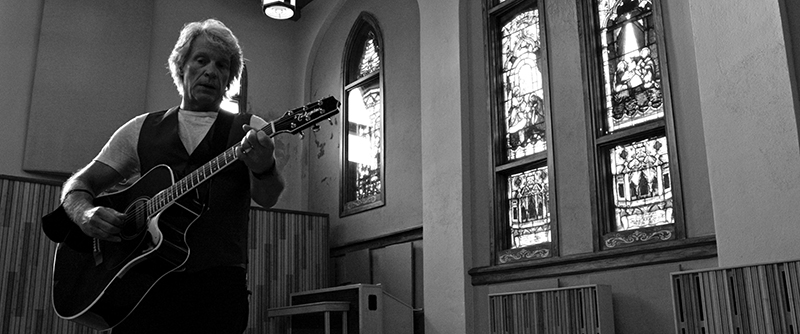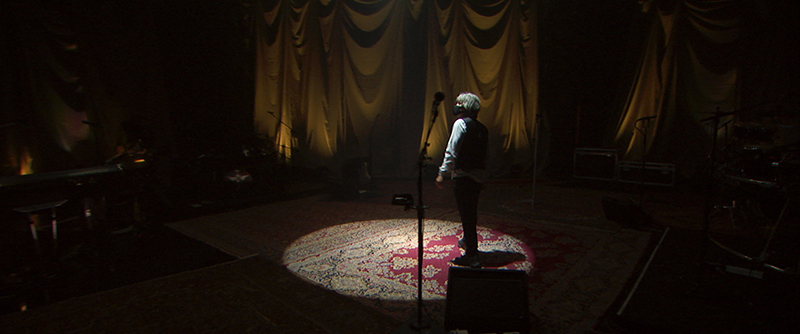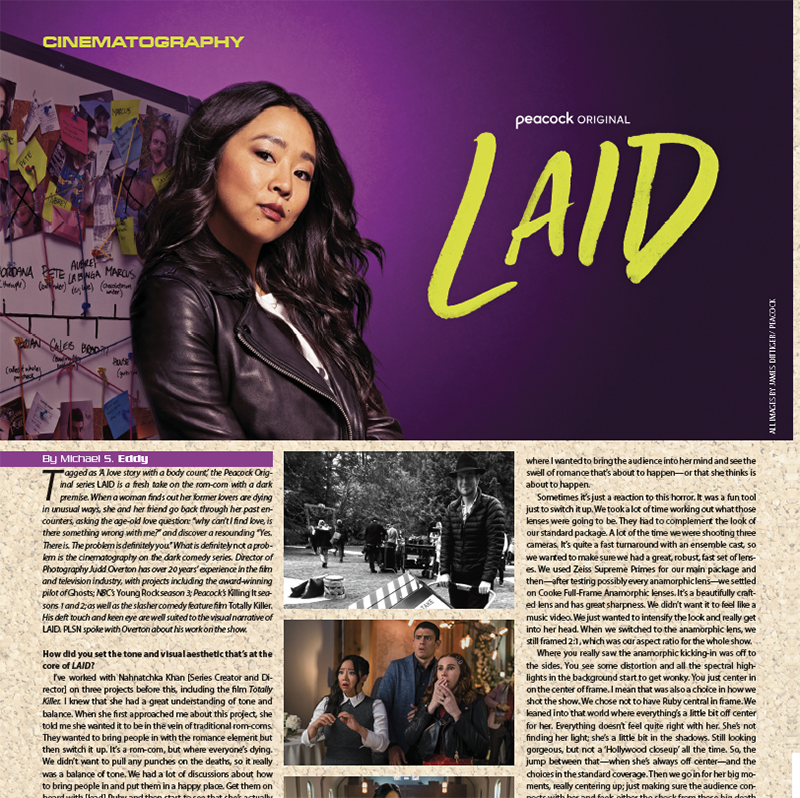
In a featureless enclosure made starker and more surreal in black and white, one band member after another takes a seat as a hand enters the frame holding a long swab. We know what’s coming: the swab’s cotton end disappears into each man’s nostril, just as tens of millions of us have experienced since the national quarantine began back in March.
The last face we see in close-up turns out to be none other than Jon Bon Jovi, his mouth covered by a black mask, but who nonetheless flashes the camera a grin that exceeds the mask’s edges, followed by a thumbs-up sign. He and his band have come together for the first time since the pandemic closed down live entertainment venues, ready to perform their music in lieu of the tour they had no choice but to cancel. Happily for us, the band made the decision to share songs from their topical new album, 2020, despite the lack of cheering crowds and dancing fans.

A Non-Concert Video
On a Night Like This: Bon Jovi 2020, a non-concert video available for free on YouTube at plsn.me/bonjovi, provides an unusually intimate performance experience in a studio in Nashville, on what Jon tells us is Day 167 of the Covid shutdown.
“The album was meant to have been released in May,” Jon says on camera, “and then Covid hit, and the world shut down, and everything changed. We had to delay it ‘til October.” With the world in turmoil, Jon wrote more songs, working to capture the heart of the pandemic experience. “These songs are mine, but they belong to everybody, because we’re living this experience together,” he tells us. “This is an album of ‘We, the People.’”
Directed and produced by Alex Horwitz with Jonathan Furmanski as director of photography, this remarkable video eschews the light shows, special effects, or wild angles usually associated with concert films — a direction chosen by design, according to Horwitz, when he and Furmanski responded to my questions by email.
“It’s a whole new world of production, with tests, masks, and distancing,” he said. “Everyone, from PAs to Jon Bon Jovi, was very gracious about it and respectful of the process, but I’d be lying if I said it’s not a challenge. I decided to lean into it and make it part of the texture of the show. The opening shots are close-ups of the band members getting Covid swabs up their noses, and Jon and I made sure that his on-camera introductions addressed the awkwardness of an audience-less concert. So we embraced the challenge. What else can one do in 2020?”

Up Close and Personal
Horwitz has directed a number of documentaries, including 2019’s Autonomy, on the development of self-driving cars, and the 2016 chronicle Hamilton’s America, about the making of the megahit Broadway phenomenon. Directing a live performance in the time of Covid, however, posed special challenges.
“It’s to do with that awkwardness I mentioned,” he said. “The substance of this album’s songs is very topical, very immediate to the audience’s experience these days. Jon said he wanted a ‘stripped down’ presentation, to eliminate distractions from the music itself. That’s a twist because Bon Jovi is a band that plays to packed arenas. We’re not used to seeing them play for nobody, so playing to an empty house would be distracting, to be sure. Once again, I just leaned into the unique circumstances.”
The result is almost cozy, a sense that we’re hanging out in the band’s garage rather than watching icons perform. “I’m glad to hear you say that,” Horwitz said. “The Steadicam was probably my biggest tool in the kit. Since I didn’t have to worry about obstructing Jon from an audience’s sightline, I could fly that Steadi right in front of him, weaving between him and his bandmates. And I told him to find that lens whenever it felt right. But [Jonathan] and I also filmed two-camera verité footage with the band for a few days leading up to the concert. We got rehearsals, some beauty B-roll, and a nice scene with Jon visiting the studio where they recorded the album. These are intimate, fly-on-the-wall moments with the band that we weave throughout the film.”
Horwitz saw the need to forego the traditional configuration of a rehearsal for an upcoming concert. “The band had been rehearsing in their normal formation: facing out, to an absent crowd. So I suggested that they face each other, and we’d shoot it in the round to make it more of a conversation than a spectacle. And Jon was very good at being disarming on camera. After the first song, he starts clapping, laughs, and says, ‘There’s the applause!’”
“A key moment was when Alex pitched the idea of having the band perform in the round, which is unusual but gave us some more interesting camera angles and created the feeling that the band was performing for each other,” said Furmanski. “I think if we had had more traditional staging, with the band facing one direction towards an empty room, it would have felt staler — even MTV Unplugged had a couple hundred people watching. And there was the added benefit of the easy social distancing in that setup. When the band first heard the idea it raised some eyebrows, but when they saw the arrangement at the rehearsal space they embraced it; it struck a nice balance between the intimacy we wanted and the social distancing we needed.”
Furmanski — whose many DP credits include 20 episodes of Oprah’s Master Class, the entire Inside Amy Schumer series and the TBS series Search Party — understood the direction this video should take from the beginning. “[Alex] and I had several conversations going into this shoot about the style, and one thing we agreed on immediately was to try and make it feel intimate, like the band was performing in your living room,” he said. “The Covid pandemic was undeniably part of the show…so we wanted people stuck at home to feel more like the band was coming to them than they were missing out on something. We were inheriting an existing concert setup from another production, so we tried to craft something that would feel a bit more stripped-down…than a full-blown live event.”
Lighting Challenges
This blend of musical artistry and harsh reality get further emphasis from the video’s lighting — a significant challenge in the small space. “I have to give credit to our great crew, most of whom met us for the first time the day before the shoot!” said Furmanski. “Alex and I gave our lighting designer, Mark Carver, the broad strokes of our plan, then he and his team did an amazing job designing the look — more or less on the fly.”
With a backdrop of several neutral canvas drops hung behind the band members and a large oriental rug covering the floor, Carver hit the fabric with color washes and the occasional gobo for texture. He maintained a pure, white light on Jon throughout most of the songs, and adds a pool of light for each musician in songs including “Let It Rain,” emphasizing the social distance between them.
“The camera crew also had some real challenges, thanks to the in-the-round staging; it was tricky finding good angles on all the band members while still leaving room for our handheld, jib arm, and Steadicam operators to do their thing,” Furmanski continued. “Luckily we were able to thread some needles — we literally had lenses poking through vertical truss — and the band’s arrangement meant we weren’t relying on long shots a hundred feet away. We could be closer and wider with our cameras and unleash our Steadicam operator, John Perry, in the middle of the floor, making it feel even more intimate. And frankly, Jon Bon Jovi is such a consummate performer, just point a camera at him and make sure you have an exposure! It all goes back to that stripped-down, living room vibe we were hoping to achieve.”
One-on-one conversations with Jon and moments with other band members all maintain the black-and-white, documentary-style visual theme begun at the outset. “For the documentary material, we shot with the Sony Venice in full-frame mode, letterboxed for an anamorphic aspect ratio (2.39:1), using Canon K35 spherical lenses,” said Furmanski. “The only light I had was a 1×1 LED panel, which I only used for an on-the-fly interview with [Jon].”
This made the most of the contrast between the doc footage and the high-resolution, full color video used for the performances. “It’s also exciting to mix full-frame documentary footage from the Sony Venice using vintage Canon lenses with more traditional and modern 4K cameras covering the live show,” he said. “I love it when I get to use every tool in the shed!”
Capturing a Crisis
The result is a time capsule, one that captures the realities of this year-out-of-time and its meaning for everyday lives, while allowing us to glimpse its impact on one of the nation’s biggest rock stars. Some journalists have mused about the volume of artistic expression that may come out of the pandemic, so the video’s first song, “Do What You Can,” gives us a prime example, reflecting the experience of virtually every listener:
Tonight they’re shutting down the borders
And they boarded up the schools
Small towns are rollin’ up their sidewalks
One less paycheck comin’ through
I know you’re feelin’ kinda nervous
We’re all a little bit confused
Nothing’s the same, this ain’t a game
We gotta make it through
“I really enjoyed being a part of this production,” said Furmanski, “not just because it married two things I love — a documentary film and live music — but because it meant I could work with my friend Alex, meet a lot of great people in the great city of Nashville, and watch one of the best rock-n-roll front men in history perform. It’s also great that we were able to put this out in the middle of a pandemic and give people something to enjoy while stuck at home.”
“I just hope people enjoy it and feel like they got to go to a concert from the safety of their homes,” said Horwitz. “There’s been a lot less live music in the world lately, so we were just trying to fill that void as best we could. There have been some streamed awards-show and festival programs, but I’m not seeing much in the way of artists filming their acts in their entirety as long-form pandemic entertainment. I think so far, it’s just Taylor Swift and Bon Jovi on the same weekend. And if Tay-Tay and JBJ can’t carry our hearts through this pandemic, I’m pretty sure no one can.”
Randi Minetor is an author and freelance journalist based in upstate New York.



